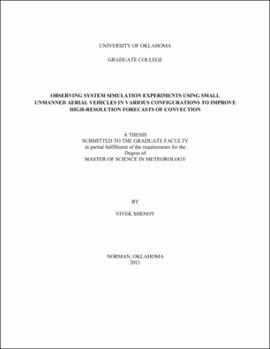| dc.contributor.advisor | Brewster, Keith | |
| dc.contributor.author | Shenoy, Vivek | |
| dc.date.accessioned | 2021-09-16T18:44:56Z | |
| dc.date.available | 2021-09-16T18:44:56Z | |
| dc.date.issued | 2021 | |
| dc.identifier.uri | https://hdl.handle.net/11244/330811 | |
| dc.description.abstract | There has been a lot of interest and development of small Unmanned Aerial Vehicles (sUAVs) to
obtain atmospheric measurements for research and operations. Some have proposed a 3D Mesonet
concept to add vertical profiling to mesonets such as the Oklahoma Mesonet. Observation System
Simulation Experiments (OSSEs) are an effective tool to measure the impact of a proposed
observing system before a complete set of observations are available, and thus are the ideal tool to
study different configurations of sUAVs that may be deployed in such a 3D Mesonet.
In this OSSE study, a Nature Run is constructed using a short term 3 km and 1 km WRF nested
model forecast covering Oklahoma and parts of surrounding states. Simulated sUAV profiles, as
well as observations representing standard existing observations, are created from the WRF model
forecast. The observations are then assimilated into the ARPS hourly for 6 hours. The case being
examined is the May 20, 2013 severe weather outbreak in central and eastern Oklahoma. The
sUAV system’s ability to update the background forecast for conditions on May 20, focusing on
convective initiation and early storm development in the afternoon, is assessed.
To examine the effect of adding simulated sUAV observations, experiments are run to test the
impact of sUAV simulated observations at various max heights to 3 km. The number of simulated
sUAV observations is also varied up to 108 sites. Additional experiments were run to test the
impact of adjusting analysis parameters, changing the time interval of observations down to 30
minute intervals and adjusting the start time of the assimilation of data.
From the forecasts of convection in the OSSE experiments, we can clearly see positive impact
from the addition of the sUAV observations in the convective initiation and early storm evolution.
The quantitative impacts on the forecast state variables show clear positive dependence on the
height of the sUAV data assimilated. There is also improvement in timing and placement of
convection when the interval of consecutive UAV obs is reduced from hourly to every 30 minutes.
However, there is not as much improvement in fitting the UAV sites to the average site density for
50 or fewer UAV sites, nor is there a clear linear relationship between delaying start times of
consecutive hourly UAV obs and the areal coverage and placement of convective initiation. It is
also found that decreasing the sUAV observation interval to 30 minutes from 1 hour while using
50 sites cannot replicate the results from using 108 sites. | en_US |
| dc.language | en_US | en_US |
| dc.subject | Unmanned Aerial Vehicle | en_US |
| dc.subject | UAV | en_US |
| dc.subject | Observing System Simulation Experiment | en_US |
| dc.subject | OSSE | en_US |
| dc.subject | observation needs | en_US |
| dc.subject | aviation | en_US |
| dc.subject | high-resolution numerical weather prediction | en_US |
| dc.subject | boundary layer evolution | en_US |
| dc.subject | drylines | en_US |
| dc.subject | severe weather | en_US |
| dc.title | Observing System Simulation Experiments Using Small Unmanned Aerial Vehicles in Various Configurations to Improve High-Resolution Forecasts of Convection | en_US |
| dc.contributor.committeeMember | Chilson, Phillip | |
| dc.contributor.committeeMember | Carr, Frederick | |
| dc.date.manuscript | 2021-08-27 | |
| dc.thesis.degree | Master of Science in Meteorology | en_US |
| ou.group | College of Atmospheric and Geographic Sciences::School of Meteorology | en_US |
| shareok.orcid | 0000-0002-4299-6171 | en_US |
